Identification of the Factors Influencing the Baseflow in the Permafrost Region of the Northeastern Qinghai-Tibet Plateau
Abstract
:1. Introduction
2. The Study Area
3. Materials and Methods
3.1. The Model Improvement and Parameter Optimization
3.2. Baseflow Simulation
3.3. Validation of the Baseflow Simulation
4. Results
4.1. Simulation Effect of the Modified VIC Model
4.2. Baseflow Processes in the Study Area
4.3. The Temporal and Spatial Variations of the Baseflow
4.4. The Impacts of the Different Factors on the Baseflow
4.4.1. The Impacts of Climate Change on the Baseflow
4.4.2. The Impacts of Land Cover on the Baseflow
4.4.3. The Impacts of Active Layer Changes on Baseflow in Permafrost Regions
5. Conclusions and Discussion
Acknowledgments
Author Contributions
Conflicts of Interest
References
- Qin, J.; Ding, Y.J.; Yang, G.J. The hydrological linkage of mountains and plains in the arid region of northwest China. Chin. Sci. Bull. 2013, 58, 3140–3147. [Google Scholar] [CrossRef]
- Qian, K.; Wan, L.; Wang, X.; Lv, J.; Liang, S. Periodical characteristics of baseflow in the source region of the Yangtze River. J. Arid Land 2012, 4, 113–122. [Google Scholar] [CrossRef]
- Arnold, J.G.; Allen, P.M.; Muttiah, R.; Bernhardt, G. Automated baseflow separation and recession analysis techniques. Groundwater 1995, 33, 1011–1018. [Google Scholar] [CrossRef]
- Rogger, M.; Chirico, G.B.; Hausmann, H.; Krainer, K.; Bruckl, E.; Stadler, P.; Bloschl, G. Impact of mountain permafrost on flow path and runoff response in a high alpine catchment. Water Resour. Res. 2017, 53, 1288–1308. [Google Scholar] [CrossRef]
- Gärtner-Roer, I.; Christiansen, H.H.; Etzelmüller, B.; Farbrot, H.; Gruber, S.; Isaksen, K.; Kellerer-Pirklbauer, A.; Krainer, K.; Noetzli, J. Primary Impacts of Climate Change on the Cryosphere—Permafrost. In Impacts of Climate Change on Snow, Ice, and Permafrost in Europe: Observed Trends, Future Projections, and Socioeconomic Relevance; ETC/ACC Technical Paper 2010/13; Voigt, T., Füssel, H.-M., Gärtner-Roer, I., Huggel, C., Marty, C., Zemp, M., Eds.; European Topic Centre on Air and Climate Change: Bilthoven, The Netherlands, December 2010; pp. 66–76. [Google Scholar]
- Cremonese, E. An inventory of permafrost evidence fort the European Alps. Cryosphere 2011, 5, 651–657. [Google Scholar] [CrossRef] [Green Version]
- Boeckli, L.; Brenning, A.; Gruber, S.; Noetzli, J. A statistical approach to modelling permafrost distribution in the European Alps or similar mountain ranges. Cryosphere 2012, 6, 125–140. [Google Scholar] [CrossRef] [Green Version]
- Yinsheng, Z.; Ohata, T.; Kadota, T. Land-surface hydrological processes in the permafrost region of the eastern Tibetan Plateau. J. Hydrol. 2003, 283, 41–56. [Google Scholar]
- Smakhtin, V.U. Low flow hydrology: A review. J. Hydrol. 2001, 240, 147–186. [Google Scholar] [CrossRef]
- Chen, L.Q.; Liu, C.M.; Yang, C. Baseflow estimation of the source regions of the Yellow River. Geogr. Res. 2006, 25, 659–665. [Google Scholar]
- Wittenberg, H.; Sivapalan, M. Watershed groundwater balance estimation using streamflow recession analysis and baseflow separation. J. Hydrol. 1999, 219, 20–33. [Google Scholar] [CrossRef]
- Zhang, Y.K.; Schilling, K.E. Effects of land cover on water table, soil moisture, evapo-transpiration and groundwater recharge: A field observation and analysis. J. Hydrol. 2006, 319, 328–338. [Google Scholar] [CrossRef]
- Aksoy, H.; Wittenberg, H. Nonlinear baseflow recession analysis in watersheds with intermittent streamflows. Hydrol. Sci. J. 2011, 56, 226–237. [Google Scholar] [CrossRef]
- Liang, S.H.; Xu, D.W.; Wan, L. Periodic regularity of the baseflow in the headwater region of the Yellow river and affecting factors. Earth Sci. Front. 2008, 15, 280–289. [Google Scholar]
- Wang, Y.L.; Wang, W.K.; Qian, Y.P.; Duan, L.; Yang, Z.Y. Change Characteristics and Driving Forces of Base Flow of Yellow River Basin. J. Nat. Resour. 2008, 23, 479–486. [Google Scholar]
- Qian, Y.P.; Jin, S.Y.; Jiang, X.H.; Lin, Y.P. Influence of variation of baseflow in the upper reaches of Lanzhou on water resources of Yellow River. J. Water Resour. Water Eng. 2004, 15, 19–23. [Google Scholar]
- Quan, J.; Ma, H.L. Baseflow Separation and Its Characteristics Analysis in Shiyang River Basin. Water Resour. Power 2010, 28, 18–27. [Google Scholar]
- McNamara, J.P.; Kane, D.L.; Hinzman, L.D. An analysis of streamflow hydrology in the Kuparuk River Basin, Arctic Alaska: A nested watershed approach. J. Hydrol. 1998, 206, 39–57. [Google Scholar] [CrossRef]
- Lyon, S.W.; Destouni, G. Changes in catchment-scale recession flow properties in response to permafrost thawing in the Yukon River Basin. Int. J. Climatol. 2010, 30, 2138–2145. [Google Scholar] [CrossRef]
- Frampton, A.; Painter, S.; Lyon, S.W.; Destouni, G. Non-isothermal, three-phase simulations of near-surface flows in a model permafrost system under seasonal variability and climate change. J. Hydrol. 2011, 403, 352–359. [Google Scholar] [CrossRef]
- Yang, Z.N. Glacier Water Resources in China; Gansu Science and Technology Press: Lanzhou, China, 1991; pp. 138–139. [Google Scholar]
- Sheng, Y.; Li, J.; Wu, J.C. Distribution patterns of permafrost in the upper area of Shule River with the application of GIS technique. J. China Univ. Min. Technol. 2010, 39, 32–39. [Google Scholar]
- Zhou, J.X.; Wu, J.K.; Liu, S.W. Hydrograph Separation in the Headwaters of the Shule River Basin: Combining Water Chemistry and Stable Isotopes. Adv. Meteorol. 2015, 2, 1–10. [Google Scholar] [CrossRef]
- Qin, J.; Ding, Y.; Wu, J. Understanding the impact of mountain landscapes on water balance in the upper Heihe River watershed in northwestern China. J. Arid Land 2013, 5, 366–383. [Google Scholar] [CrossRef]
- Zhao, Q.; Zhang, S.; Ding, Y.J. Modeling hydrologic response to climate change and shrinking glaciers in the highly glacierized Kunma Like River catchment, Central Tian Shan Mountains. J. Hydrometeorol. 2015, 16, 2383–2402. [Google Scholar] [CrossRef]
- Cherkauer, K.A.; Lettenmaier, D.P. Hydrological effects of frozen soils in the upper Mississippi River basin. J. Geophys. Res. 1999, 104, 599–610. [Google Scholar] [CrossRef]
- Troy, T.J.; Sheffield, J.; Wood, E.F. Estimation of the terrestrial water budget over northern Eurasia through the use of multiple data sources. J. Clim. 2011, 24, 3272–3293. [Google Scholar] [CrossRef]
- Cuo, L.; Zhang, Y.; Bohn, T.J.; Zhao, L.; Li, J.; Liu, Q.; Zhou, B. Frozen soiled gradation and its effects on surface hydrology in the northern Tibetan Plateau. J. Geophys. Res. Atmos. 2015, 120, 8276–8298. [Google Scholar] [CrossRef]
- Moriasi, D.; Amold, J.; Van, L.M. Model evaluation guidelines for systematic quantification of accuracy in watershed simulations. Trans. Asabe 2007, 50, 885–900. [Google Scholar] [CrossRef]
- Abdulla, F.A.; Lettenmaier, D.P.; Xu, L. Estimation of the ARNO model baseflow parameters using daily streamflow data. J. Hydrol. 1999, 222, 37–54. [Google Scholar] [CrossRef]
- Vogel, R.M.; Kroll, C.N. Regional geohydrologic-geomorphic relationships for the estimation of low-flow statistics. Water Resour. Res. 1992, 28, 2451–2458. [Google Scholar] [CrossRef]
- Qin, Y.; Yi, S.; Ren, S. Responses of typical grasslands in a semi-arid basin on the Qinghai-Tibetan Plateau to climate change and disturbances. Environ. Earth Sci. 2014, 71, 1421–1431. [Google Scholar] [CrossRef]
- Haeberli, W.; Guodong, C.; Gorbunov, A.P.; Harris, S.A. Mountain permafrost and climatic change. Permafr. Periglac. Process. 1993, 4, 165–174. [Google Scholar] [CrossRef]
- Wang, G.X.; Hu, C.H.; Li, T.B. The influence of freeze-thaw cycles of active soil layer on surface runoff in a permafrost watershed. J. Hydrol. 2009, 375, 438–449. [Google Scholar] [CrossRef]
- Li, R.; Zhao, L.; Ding, Y.J.; Wang, Y.X. Impact of surface energy variation on thawing processes with active layer of permafrost. J. Glaciol. Geocryol. 2011, 33, 1235–1242. [Google Scholar]
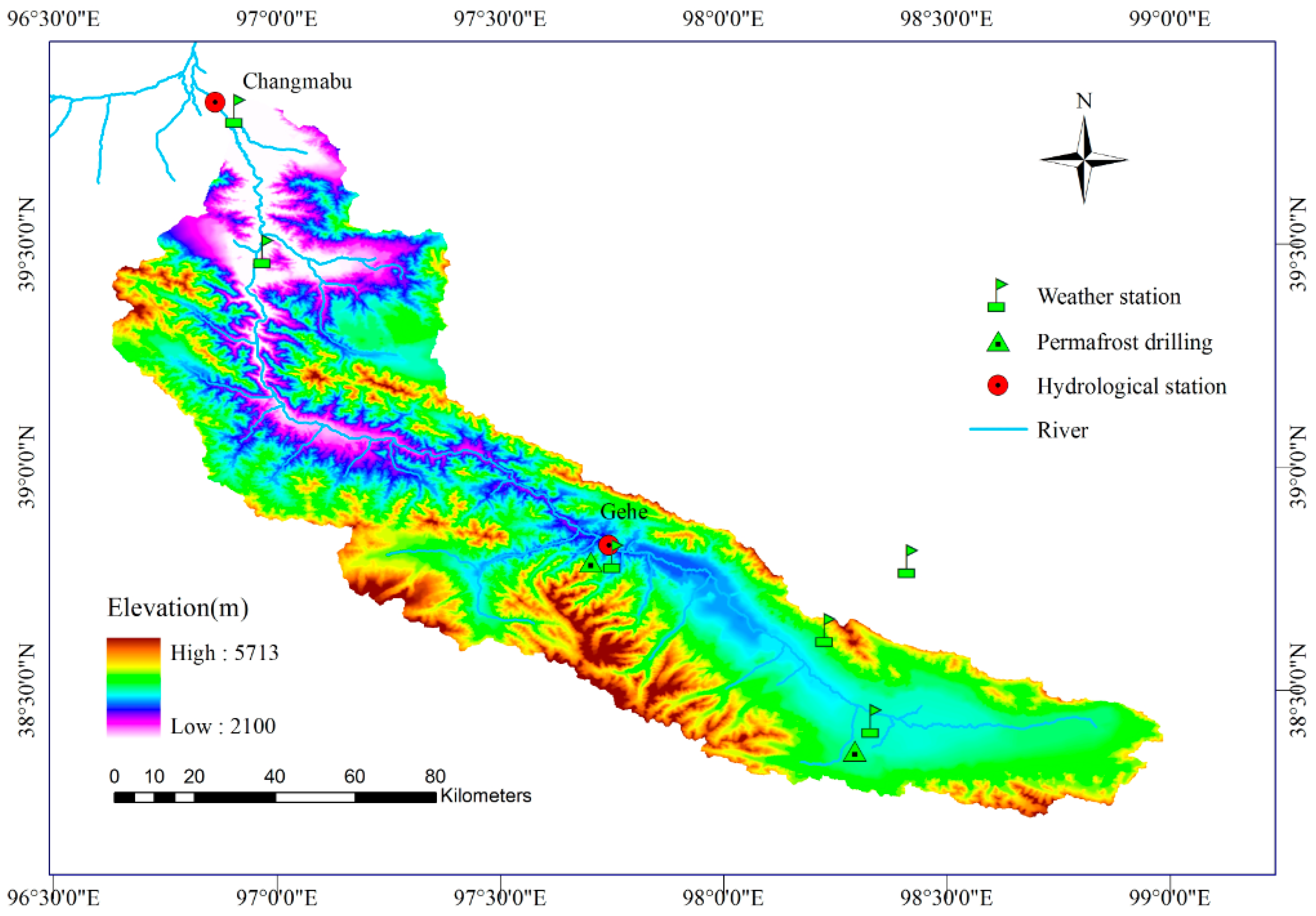

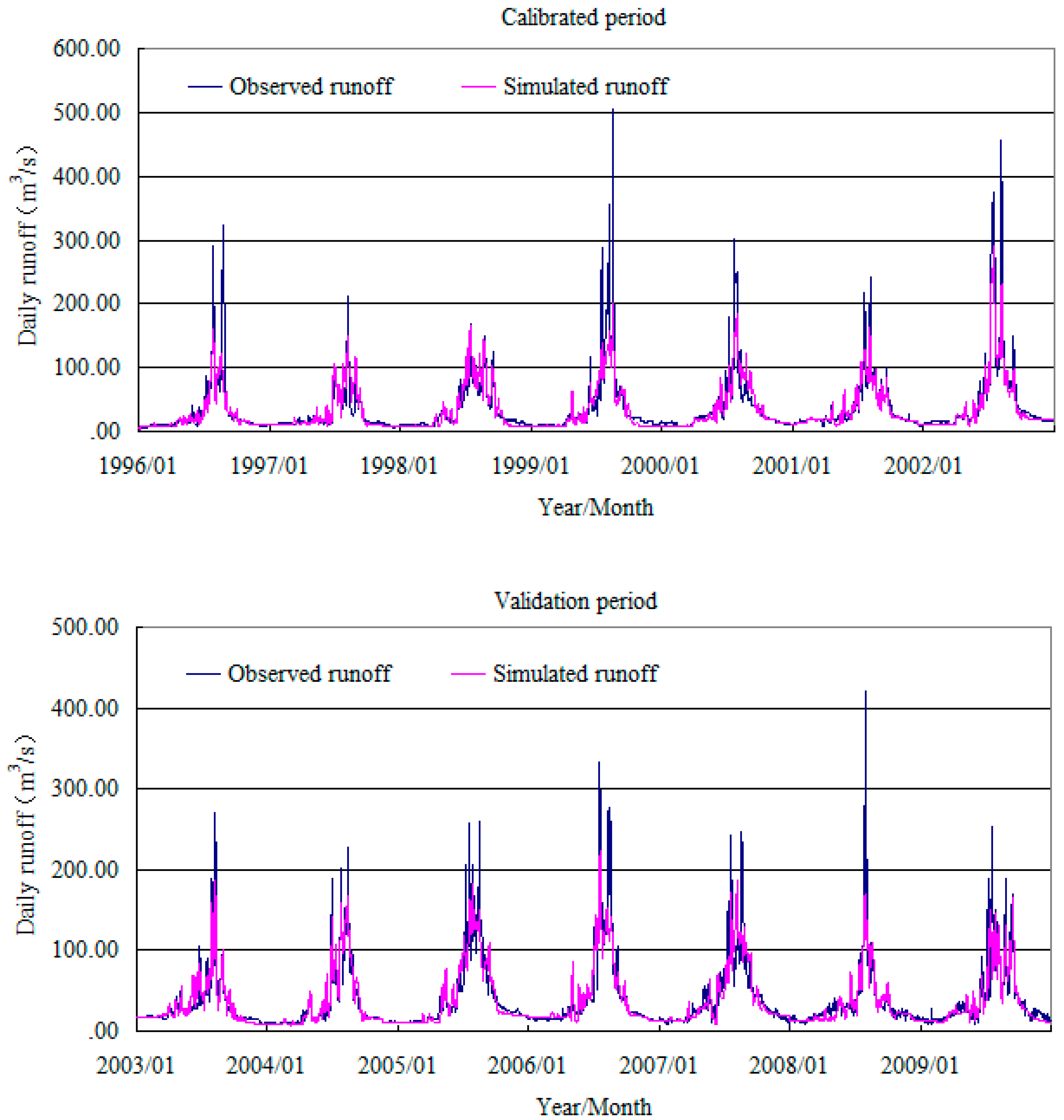

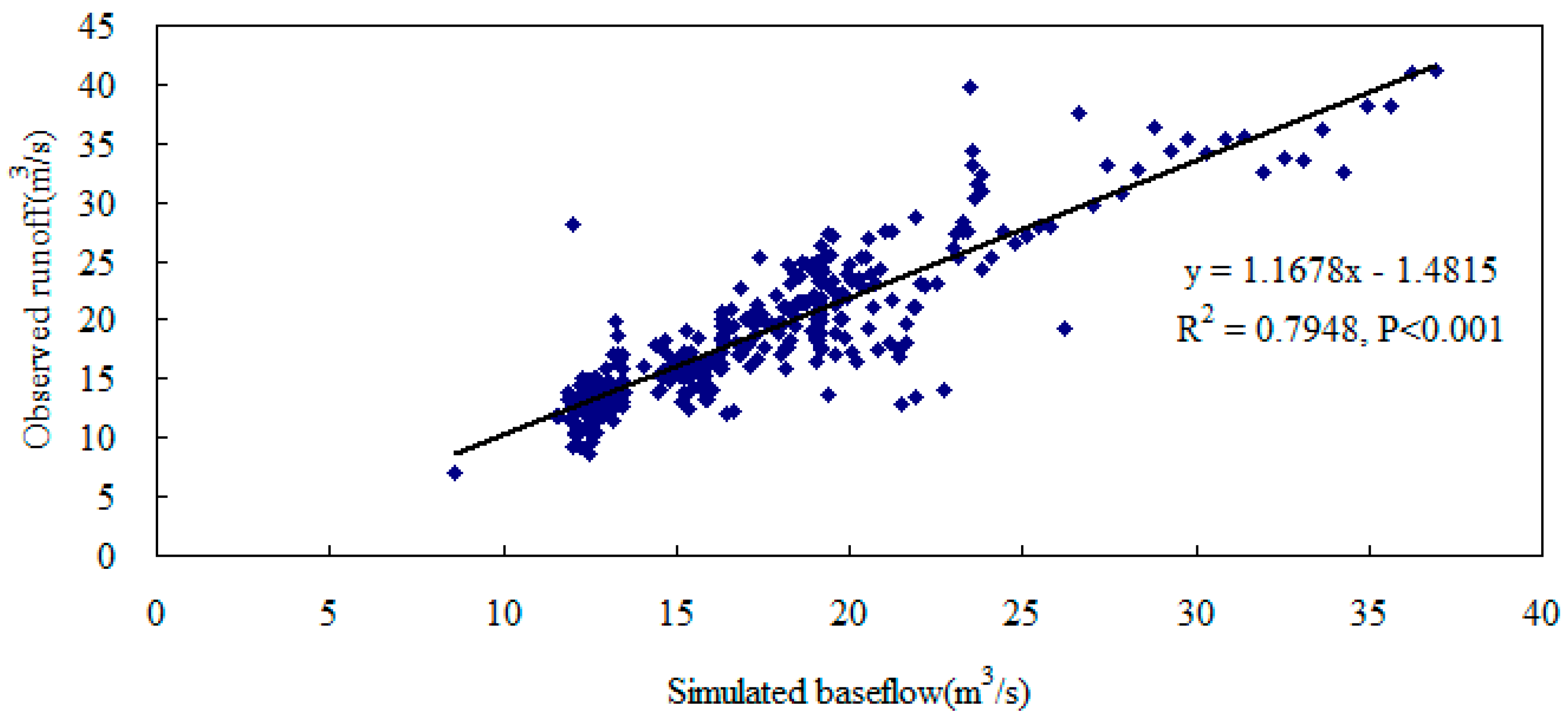
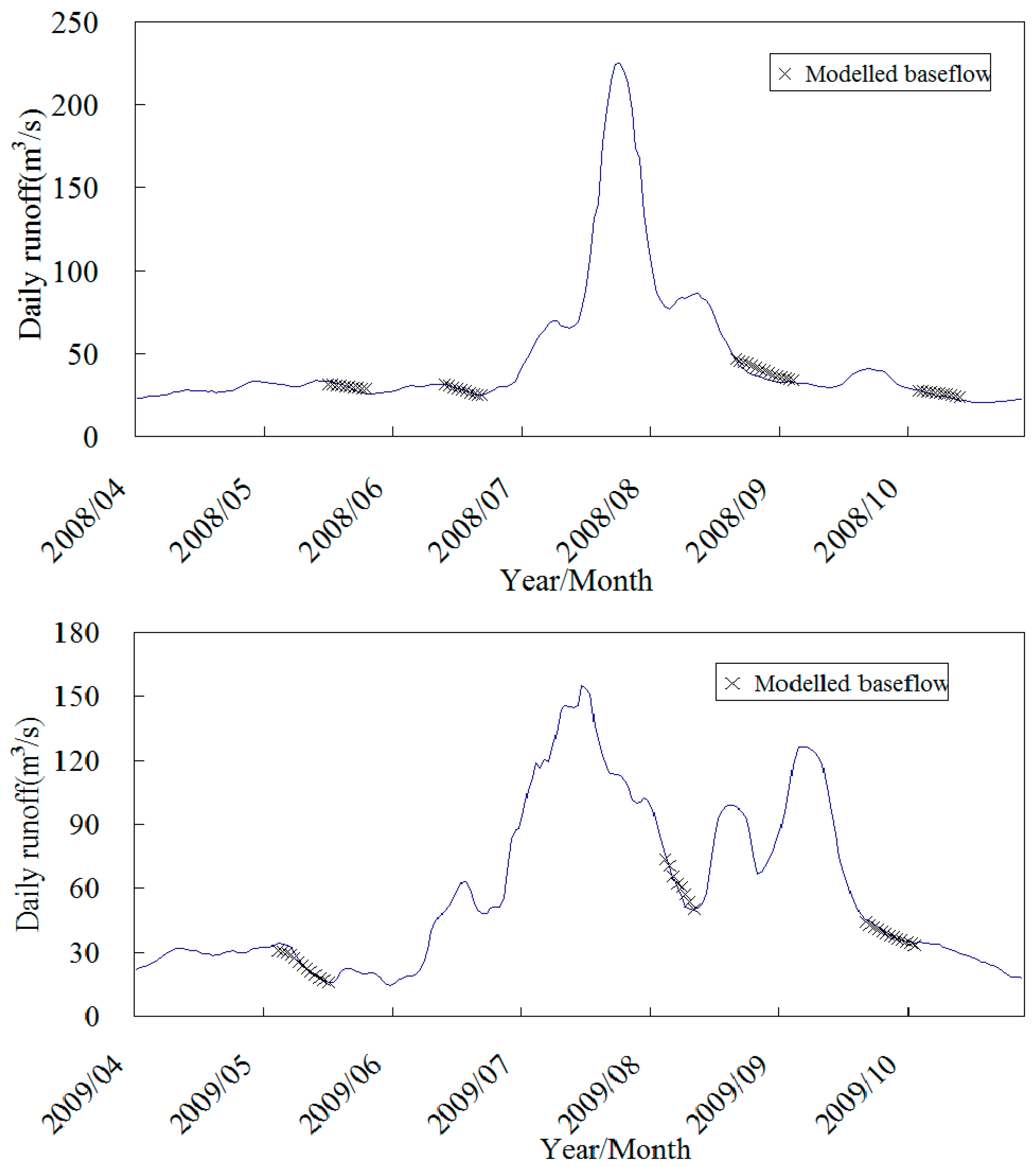
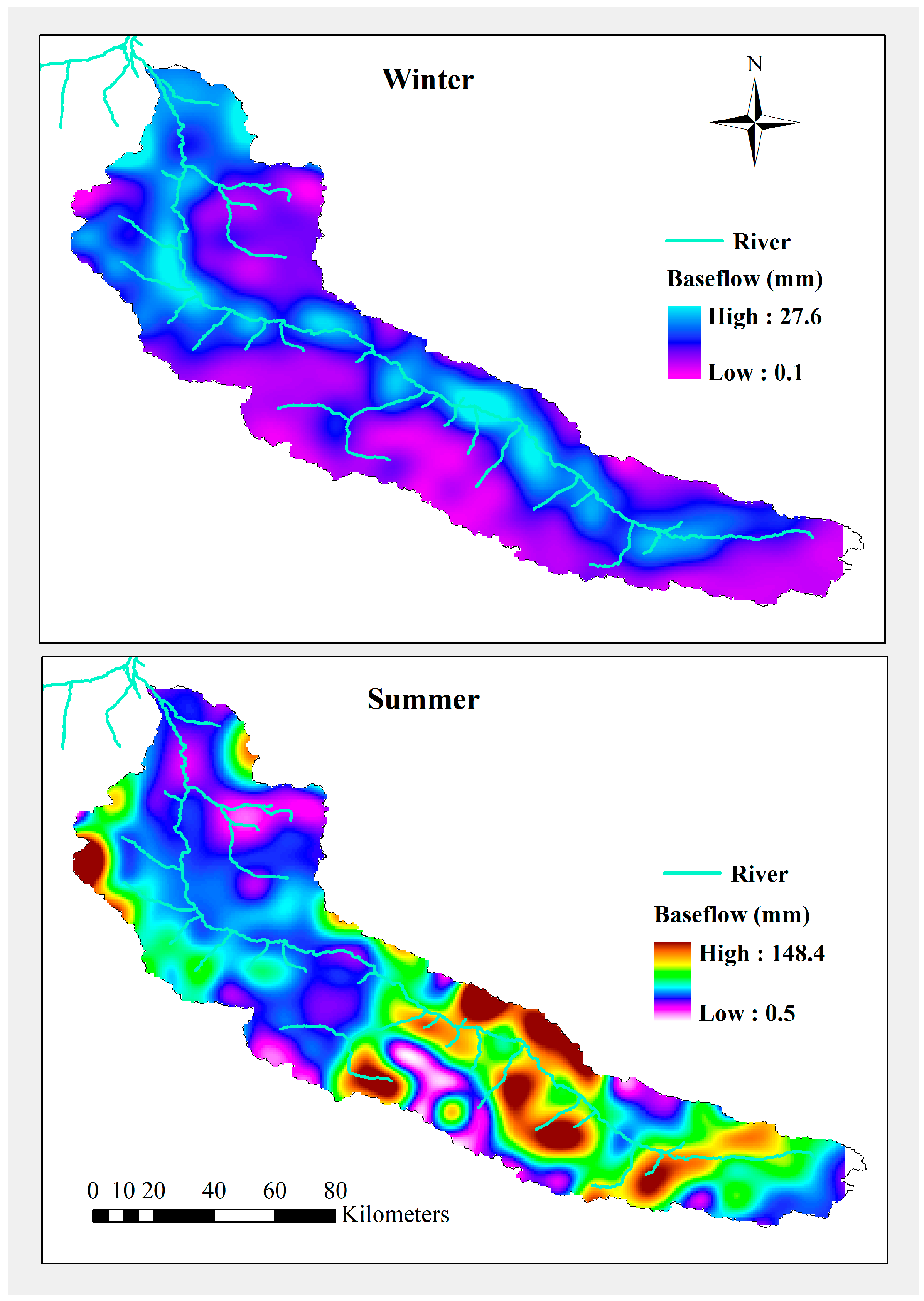
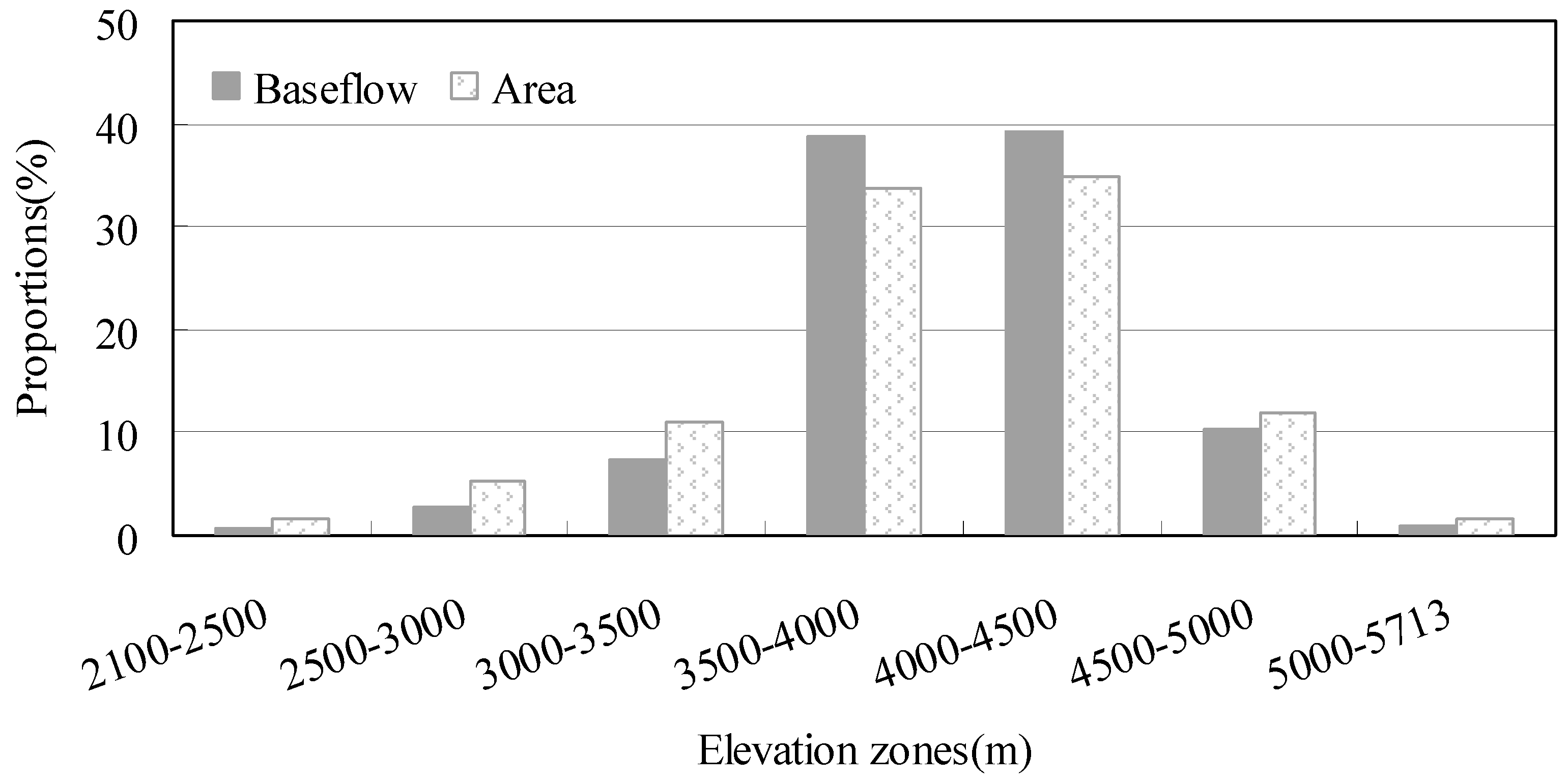
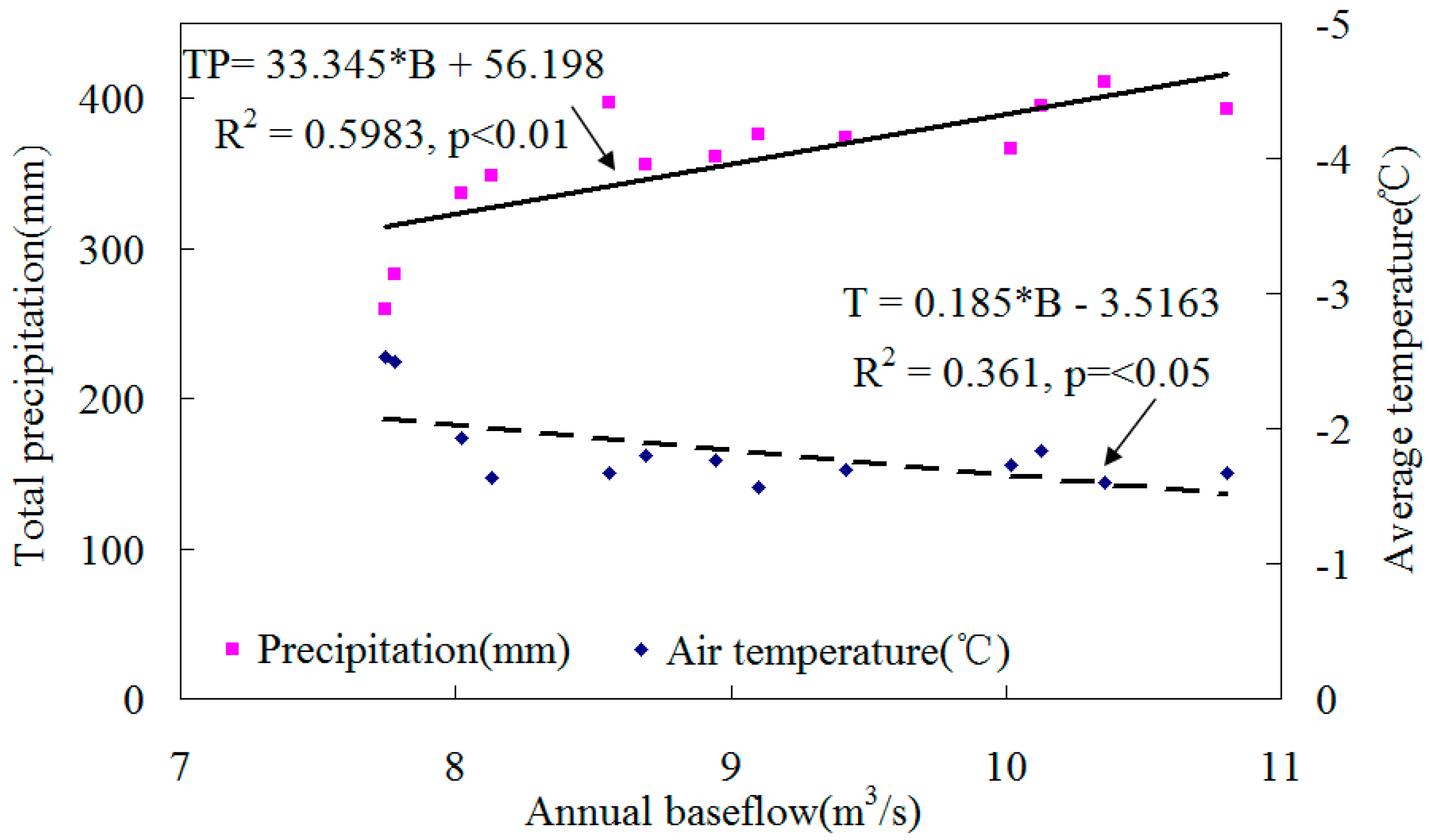
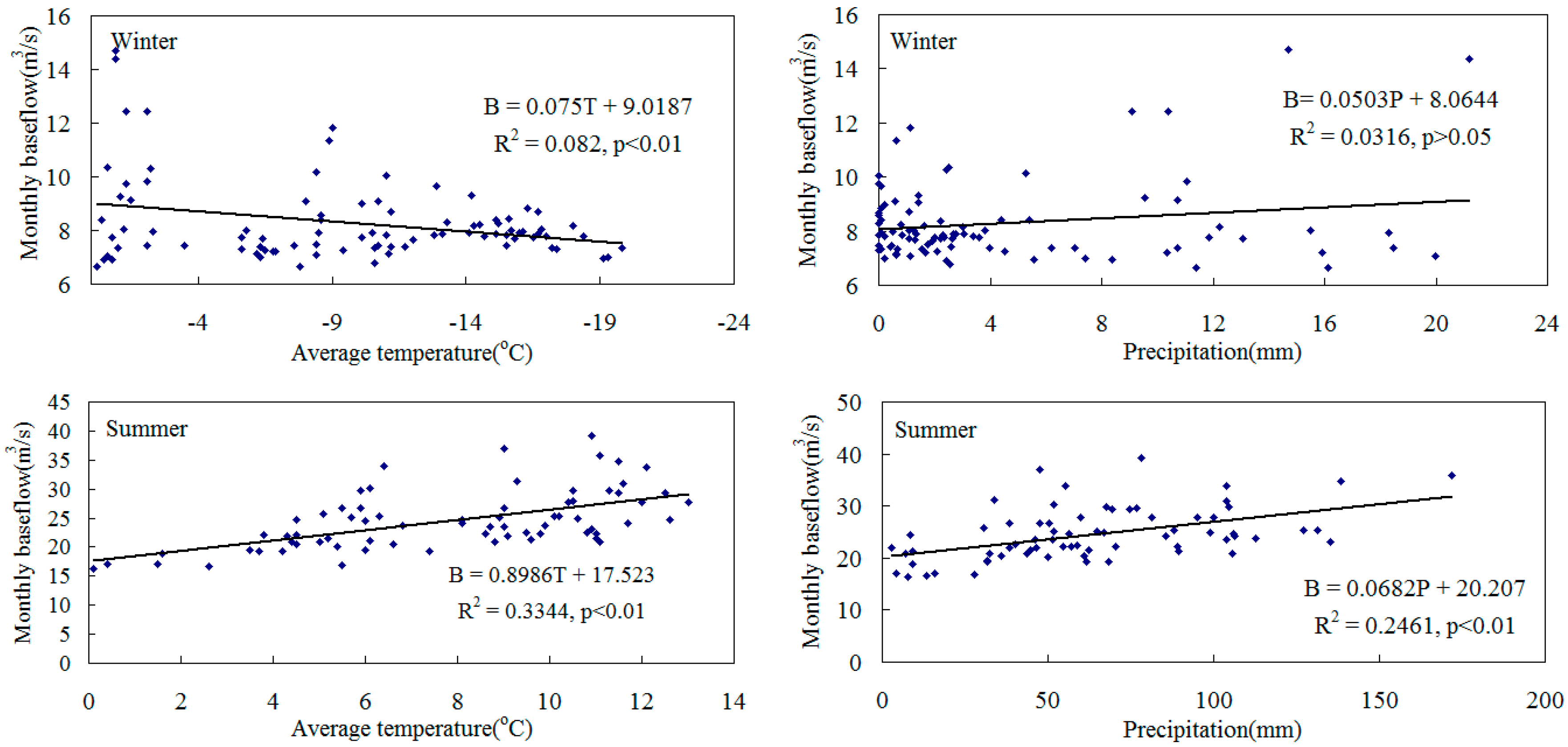
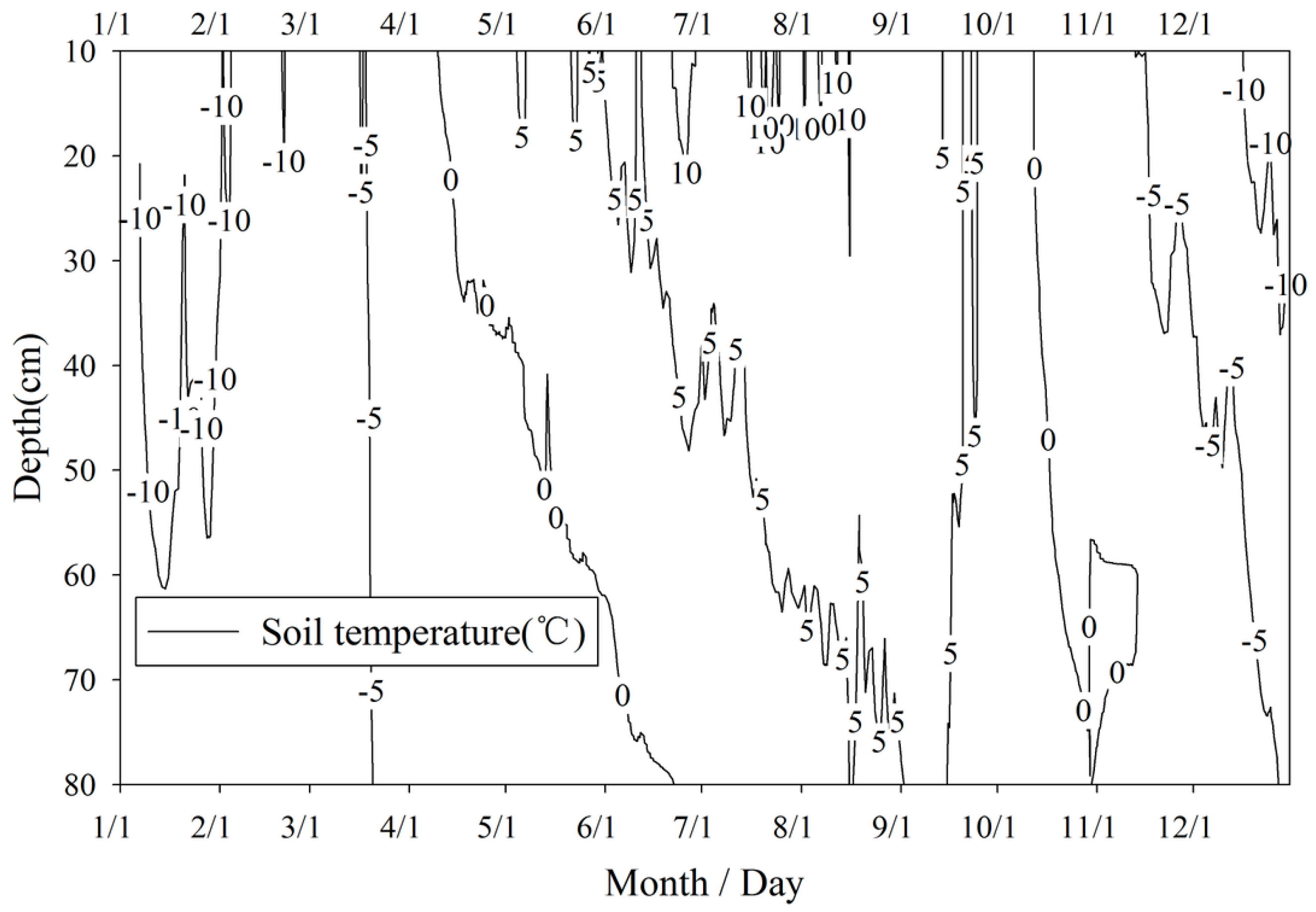
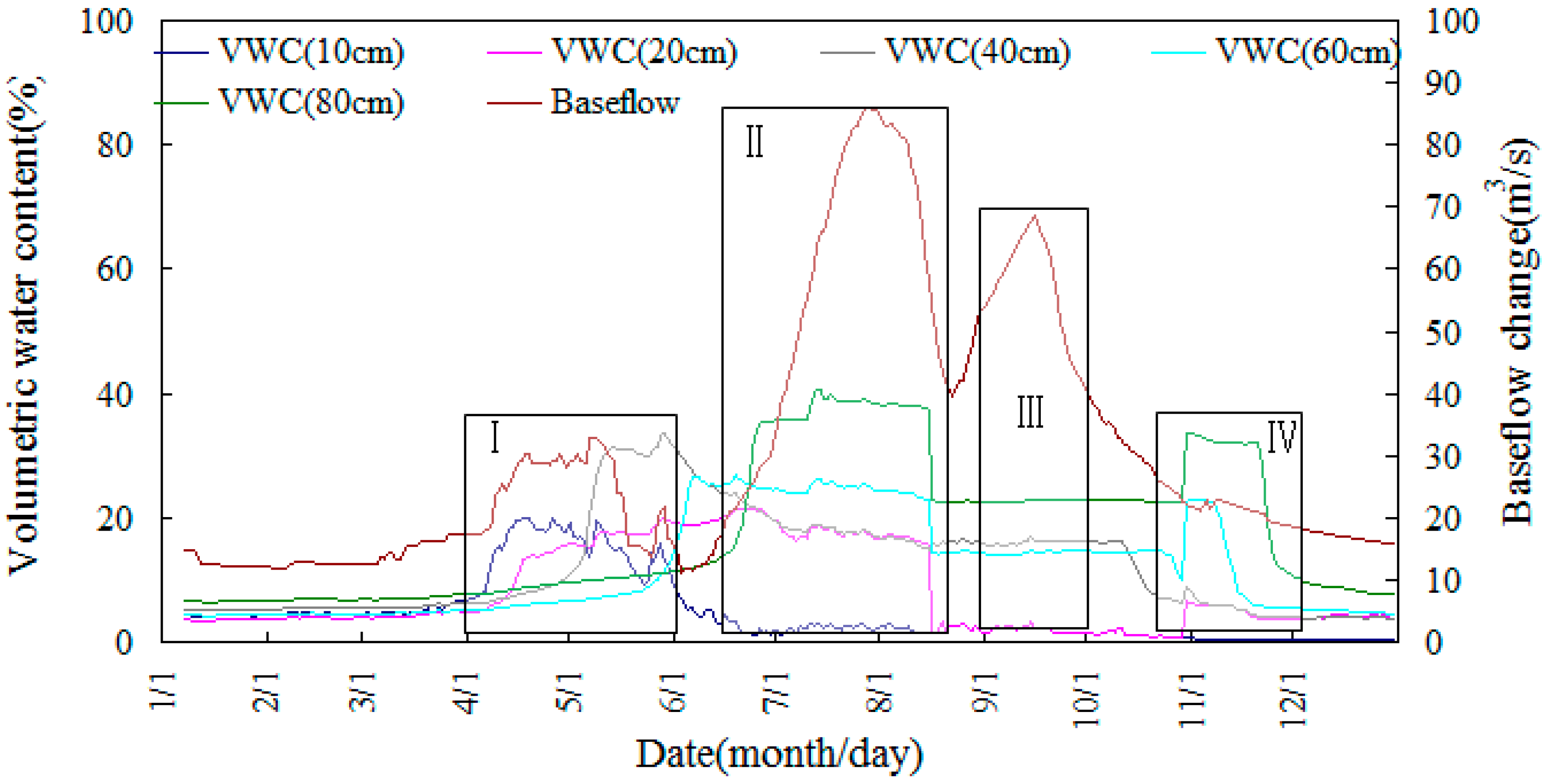
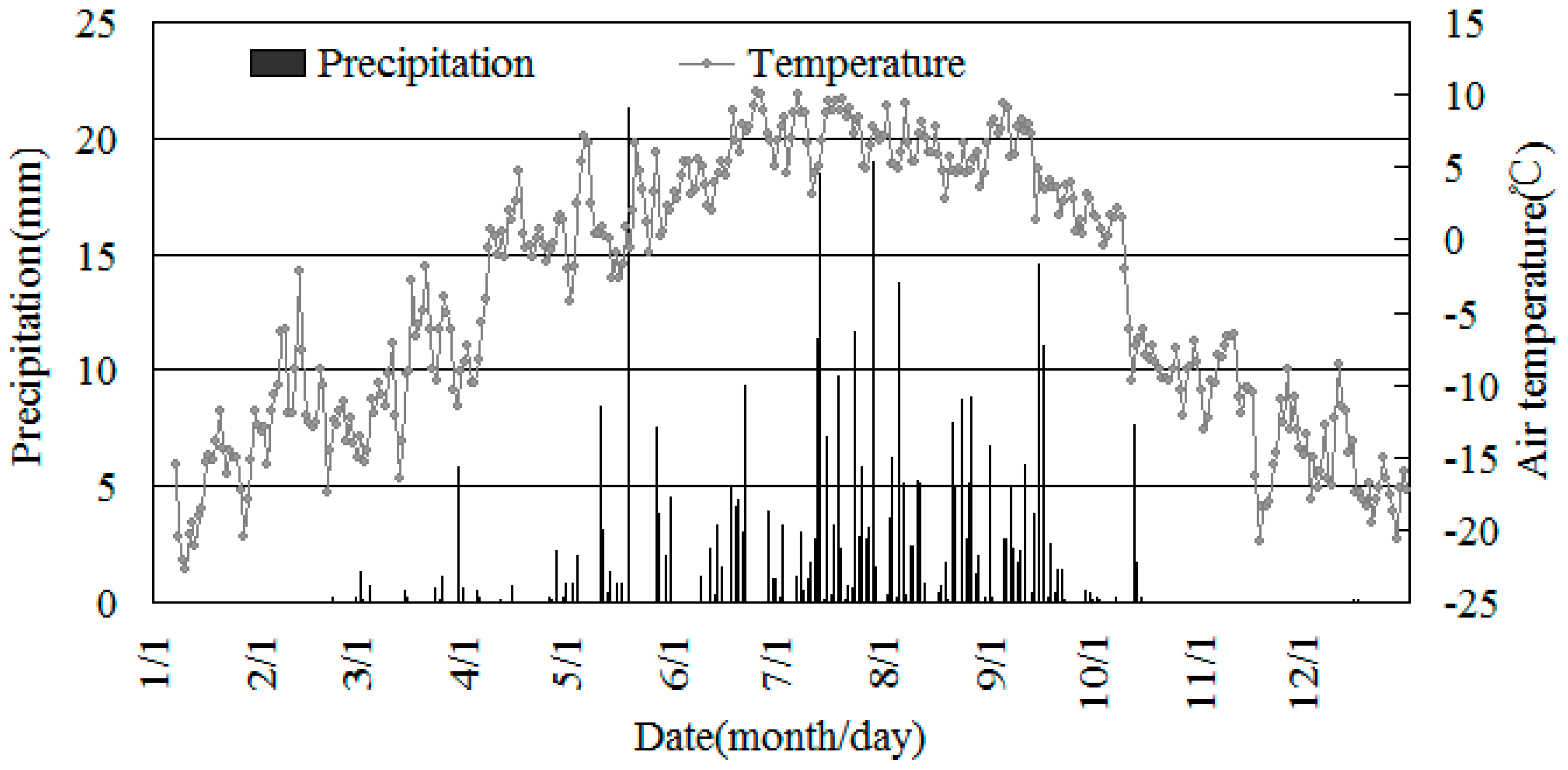
| Periods | NS | PBIAS | R2 |
|---|---|---|---|
| S W E | S W E | S W E | |
| 1996–2002 | 0.73 0.57 0.78 | 6.55 11.41 7.62 | 0.76 0.59 0.80 |
| 2003–2009 | 0.74 0.69 0.80 | 2.83 6.06 3.34 | 0.74 0.72 0.81 |
© 2017 by the authors. Licensee MDPI, Basel, Switzerland. This article is an open access article distributed under the terms and conditions of the Creative Commons Attribution (CC BY) license (http://creativecommons.org/licenses/by/4.0/).
Share and Cite
Qin, J.; Ding, Y.; Han, T.; Liu, Y. Identification of the Factors Influencing the Baseflow in the Permafrost Region of the Northeastern Qinghai-Tibet Plateau. Water 2017, 9, 666. https://doi.org/10.3390/w9090666
Qin J, Ding Y, Han T, Liu Y. Identification of the Factors Influencing the Baseflow in the Permafrost Region of the Northeastern Qinghai-Tibet Plateau. Water. 2017; 9(9):666. https://doi.org/10.3390/w9090666
Chicago/Turabian StyleQin, Jia, Yongjian Ding, Tianding Han, and Yuexia Liu. 2017. "Identification of the Factors Influencing the Baseflow in the Permafrost Region of the Northeastern Qinghai-Tibet Plateau" Water 9, no. 9: 666. https://doi.org/10.3390/w9090666





